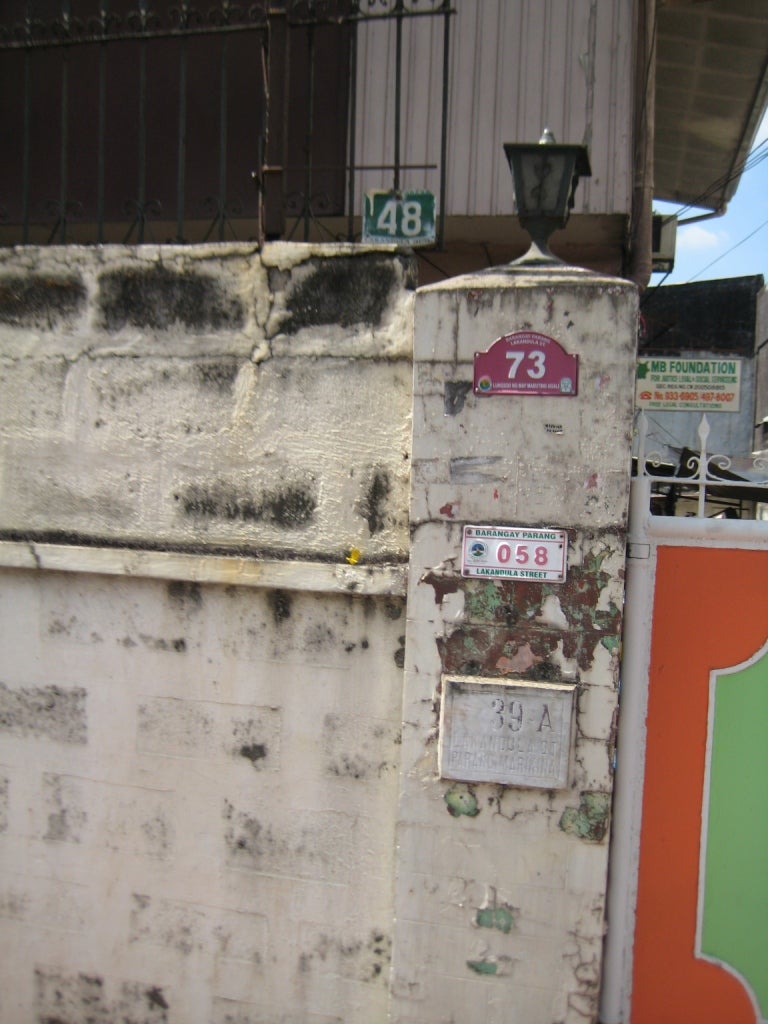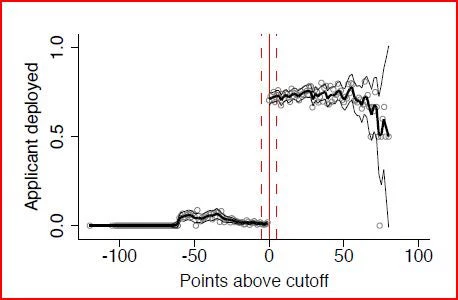Several countries around the world (notably Australia and Canada) have migration points systems- score above some points threshold and you can come in, score below and you can’t. This has intrigued me with the possibility of a regression-discontinuity design to measure impacts of migrating. However, there are several problems – the points given tend to be lumpy (e.g. 5 points for studying in the country, 10 points for being a desirable age, etc.) so that the points distribution is not very continuous. But more worryingly for an RD design, the points criteria are advertised and so motivated migrants can sometimes take steps to increase their points to just above the threshold (e.g. by taking some training course). So I had given up on the hope of RD designs for migration.
A new paper by Michael Clemens and Erwin Tiongson finds a much clearer application of an RD design in migration. They study Filipinos trying to migrate to work in manufacturing jobs in Korea through a bilateral agreement under the EPS program. (Ok, not in Gangnam district, but I might argue that some of Psy’s dance moves kind of look like a regression discontinuity). As well as fulfilling basic eligibility criteria in terms of age and education, all applicants are required to pass a 90 minute, 200 question Korean Language Test. A score of 120 points or higher is required to secure a work permit. This provides a great regression discontinuity, which the authors use to measure the impacts of this migration on households in the Philippines.
First we see a stark difference in the likelihood of being deployed on either side of the points cutoff:
They then do a survey of households with applicants scoring within 5 points of this cutoff, and measure impacts on the household (after doing the usual battery of tests to show no sorting around the threshold). This is no easy task, since they are trying to find households 3-5 years after doing this test. They have a target sample frame of 2,063 applicants, of which they are able to interview 899 (44%) – about 500 addresses could not even be located, while in the other cases there were refusals, no one home, or neighbors indicated the family had moved. They therefore do a number of checks to show that the discontinuity and comparability on observables on either side of the threshold continue to hold in the survey data.

A house with 4 different street numbers shows the challenge in locating households
How then does having a member migrate to Korea impact the remaining household? The migration is temporary, and not everyone who passes the test migrates, so they consider both ITT and TOT impacts – I will focus on summarizing the latter:
· There is no significant change in household income – remittance income goes up, but is offset by falls in other income (likely what the migrant would have contributed at home)
· Despite no increase in income, monthly expenditure increases a lot – by 30 to 60%, with the main increases coming from increases in health and education spending, and in what the authors call “quality of life” spending – a catch-all that includes recreation, gifts, household and personal care, transportation, and fuel.
· Migrant households are borrowing less from family.
· There is no significant impact on labor force participation or income earned by other household members – the fear of “remittance dependency” causing laziness and lack of work effort isn’t born out.
· Children of applicants are no more likely to be in school (enrollment is already near universal at 98% for 6-18 year olds in households just below the discontinuity), but these kids are more likely to be attending private school – so the quality of schooling may have improved.
The large impact on expenditure without any impact on income is puzzling. The authors attribute this to a possible tendency for certain types of income (e.g. gifts in-kind) to be poorly reported as income. I suspect it might also reflect a timing issue – income is measured with recall as the average over the past 6 months. If migrants have been abroad 3 to 5 years, they may have sent substantial amounts of remittances back in the first few years, which could now be being spent by the household. However, as readers of this blog know well, both income and expenditure are often tough to measure, so it could reflect measurement issues as well.
The other avenue to take this would be to try and convince policymakers to randomize within a points range – while they may have very good reasons to think someone getting 190/200 will do better in Korea than someone getting 100/200, it seems very unlikely that policymakers know for sure that someone getting 125 will do so much better than someone getting 115. Randomizing access within a range would allow policymakers to fine-tune their points systems by testing out a limited number of these marginal applicants without running the risk of letting too many in at once, while at the same time providing researchers with a good opportunity to measure development impacts of expanding migration opportunities. So if you’re reading this in Seoul (or Canberra or Ottawa), think about doing this…



Join the Conversation